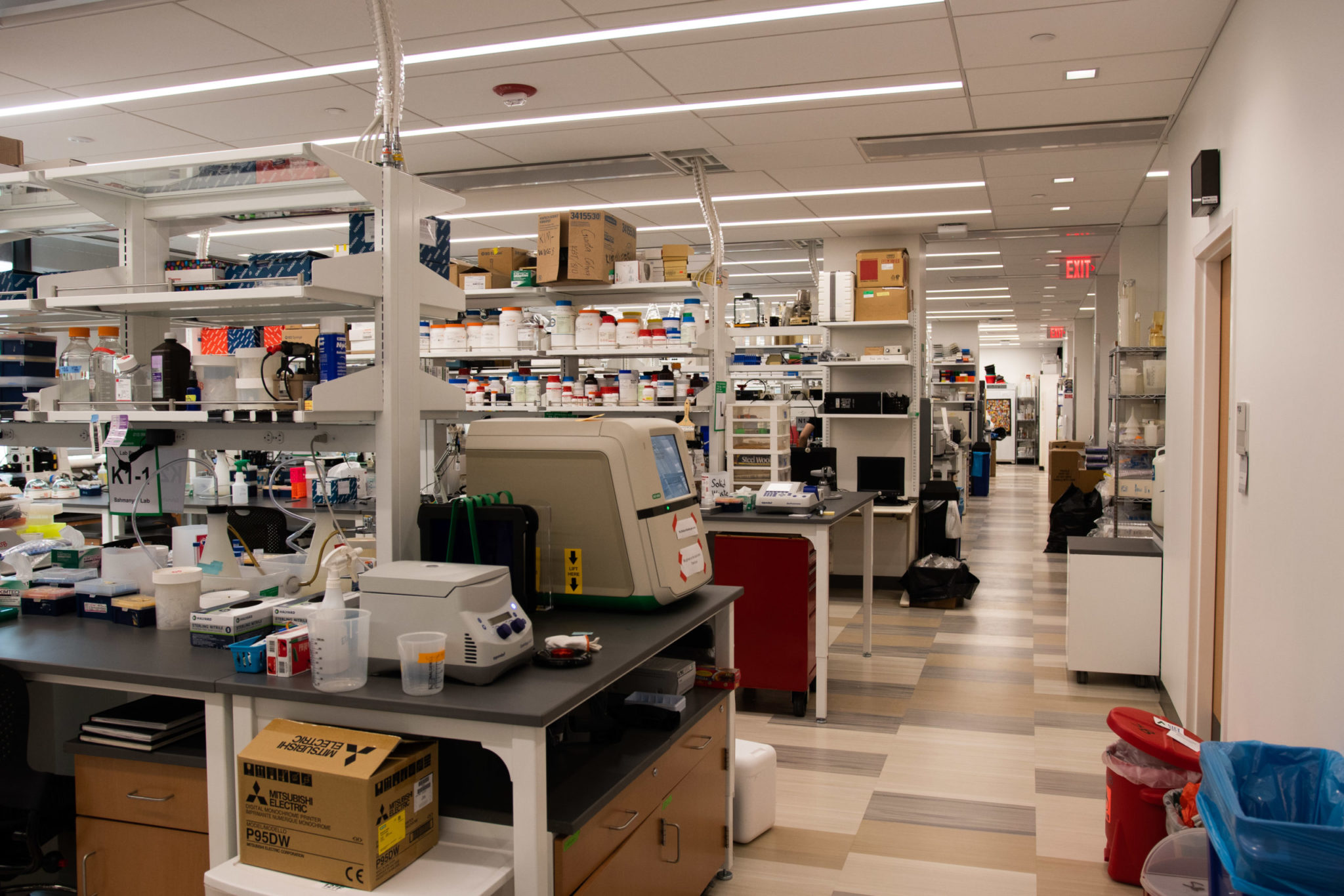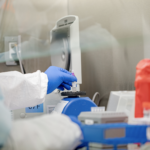With data from NBA study, FDA extends Emergency Use Authorization to Yale’s SalivaDirect COVID-19 test
The test is inexpensive, non-invasive and validated for use with reagents and instruments from multiple vendors, which researchers hope will minimize supply chain bottlenecks.

Lukas Flippo
On Saturday morning, the U.S. Food and Drug Administration (FDA) granted an Emergency Use Authorization for SalivaDirect, a saliva-based test for COVID-19 developed by researchers at the Yale School of Public Health.
The EUA paves the way for other labs that hope to begin use of the test, noted for being inexpensive to produce and implement, with the general public.
In mid-May, the NBA approached the Yale team behind SalivaDirect, curious about a potential partnership that could help validate their new saliva-based assay. The collaboration generated a plan to verify the test, as players from 22 of the NBA’s 30 teams embarked on their own experiment to recreate the season in a bubble.
Now, with the NBA-Yale study ongoing and basketball back in action, both experiments are proving successful. The test will now be rolled out this week, according to Anne Wyllie, the associate research scientist in epidemiology who helped spearhead this research at Yale.
A non-peer-reviewed preprint published earlier this month by lead researchers Wyllie and Nathan Grubaugh, an assistant professor of epidemiology, found the test to be “highly sensitive” with “high agreement” in testing outcomes when compared to widely used ThermoFisher Scientific nasopharyngeal (NP) swabs. The test is validated for use with reagents and instruments from multiple vendors, which researchers hope will minimize supply chain bottlenecks.
“Providing this type of flexibility for processing saliva samples to test for COVID-19 infection is groundbreaking in terms of efficiency and avoiding shortages of crucial test components like reagents,” FDA Commissioner Stephen Hahn said in an official release.
Other saliva tests approved by the FDA, like one developed by Rutgers, are far more expensive than SalivaDirect. In May, Vault Health was offering the test, conducted in a patient’s home with telehealth video supervision, for $150. According to the August SalivaDirect preprint, reagents for the test could cost as little as $1.29 to $4.37 per sample. Researchers estimate that Proteinase K, used for sample processing, would cost somewhere between 13 and 26 cents a sample. Primers and probes would cost a few cents. And a RT-qPCR kit would require between 75 cents and $2.11 per sample.
When labs offer tests to the public, each test should only cost $10 or less, Wyllie wrote in an email to the News. From the beginning, researchers have sought an inexpensive, flexible test that could be scaled and immune to bottlenecks.
“We’ve called it SalivaDirect because of the idea that we’re almost testing saliva directly. We’re doing a very simple intermediate treatment,” Wyllie told the News in June. “That makes it a lot cheaper and makes it a lot more high throughput and faster turnaround.”

The NBA study allows researchers to validate the test in an asymptomatic cohort, Wyllie said. In addition to receiving daily testing to ensure that they have not contracted the virus, a group of players, coaches and staff heading for the NBA’s Florida bubble volunteered to offer a saliva test sample that researchers could use to verify the efficacy of SalivaDirect.
Although she could not yet report on the study itself, Wyllie pointed out that the very success of the NBA bubble in Florida has created a unique challenge for researchers studying a new coronavirus test: there are no positive cases. Before teams entered the bubble at Disney World, 25 of 351 players tested positive for the virus between June 23 and July 2. But of the more than 340 players still receiving constant tests within the bubble, zero positive tests have been recorded over the past month, according to official NBA releases.
An NBA spokesperson did not respond to an immediate request for comment Saturday on whether the league now plans to begin using SalivaDirect in its normal testing regimen. The NBA and National Basketball Players Association contributed more than $500,000 to fund the validation study for SalivaDirect, ESPN reported Saturday. The researchers’ preprint also lists the Huffman Family Donor Advised Fund, George Mason’s Mercatus Center, the Yale Institute for Global Health and the Beatrice Kleinberg Neuwirth Fund as funders.
Grubaugh and Wyllie have both emphasized how saliva testing could change the game for detecting COVID-19. Not only has it been proven in their studies to be equally — if not more — effective as nasopharyngeal swab testing, but it is more comfortable for patients and significantly lowers the risk of infection for healthcare workers administering the tests.
The FDA also explained in its announcement that SalivaDirect is incredibly versatile, as it does not require a particular collection device. Any sterile container will work.
“This test is also unique because it does not require a separate nucleic acid extraction step,” the FDA wrote. “This is significant because the extraction kits used for this step in other tests have been prone to shortages in the past. Being able to perform a test without these kits enhances the capacity for increased testing, while reducing the strain on available resources.”
While the saliva testing method is generally more straightforward than NP swab testing, one of the potential barriers to widespread use of SalivaDirect will be getting adequate saliva samples, according to Wyllie. She said that the sample is supposed to just be “the normal saliva that naturally pools in your mouth.” Often people think it is more complicated than that, and they sniff or cough to produce saliva, which can sometimes reduce the test’s accuracy.

Wyllie told the News when the NBA study started that the ultimate goal was not to commercialize SalivaDirect, and that the protocols were already available online to the public. The FDA’s statement explains that Yale will now provide these testing protocols to other labs on an “open source” basis.
“Our goals and values hold true. There is still no kit and no commercialization,” Wyllie told the News in an email. “The method is available but we have to designate labs who can use it to make sure they follow the requirements exactly — just some oversight. However, it also means that we have a free license for commercial labs — we want to have conversations about them for testing.”
By following the instructions put out by Wyllie and Grubaugh’s team, these labs will be able to get the necessary materials and easily do the test themselves, according to the FDA. This is made possible by the fact that SalivaDirect does not depend on specific equipment from Yale and can be scaled up at other laboratories.
Instructions on the Grubaugh Lab’s coronavirus-centric website, CovidTrackerCT.com, simply invite labs to email salivadirect@gmail.com to begin the process alongside a link to a detailed protocol that covers collecting spit — thinking about “favorite foods” or an “upcoming meal” can stimulate saliva production — processing the sample and reporting a result.
“I think people will move to this quite quickly — we need more tests as screening measures as we continue to reopen,” Wyllie wrote in an email to the News. “With more frequent testing we can get this virus under control. I think people are much more open to saliva than swabs!”
The Yale team submitted SalivaDirect as a laboratory developed test for FDA EUA on July 14, 2020, making SalivaDirect the fifth saliva sample test that the FDA has authorized.
William McCormack | william.mccormack@yale.edu
Charlotte Zimmer | charlotte.zimmer@yale.edu








